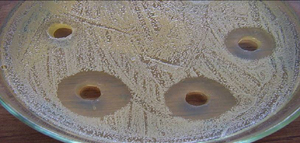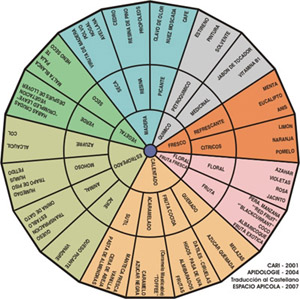|
25 YEARS OF BEEKEEPING IN THE NORTH OF SANTA FE PROVINCE: BALANCE AND CHANGES
Interview to: Daniel Massello
Calchaqui - Santa Fe - Argentina
danielmassello@csdnet.com.ar
 Daniel Massello and Fernando Esteban, February 2007 Daniel Massello and Fernando Esteban, February 2007
By the middle of February we visited Daniel Massello, a queen breeder from Arrecifes sorroungings Buenos Aires county that, escaping from the soya, came to Calchaquí, in the South of Reconquista, Santa Fe province, in 1979.
The area is in the middle of two important geographical regions, Chaco and the Pampa Húmeda with mesopotámicas characteristics for beeing near to the Paraná coast and the Low Submeridionales. Since March of 1994, when we visited for first time, up to now, the beekeeper from this area had to adapt to the deep changes that the agriculture advance imposed in the ecosystem and the increase of the climatic lack of foresight. Daniel tells us how he faced from the apiary handing those changes, approached through the following topics:
DEEP CHANGES IN THE REGION
SOYA ADVANCE IN THE REGION
BEE SELECTION AND FEEDING HANDLING
FEEDING HANDLING DURING THE SEASON
FEEDING DIAGNOSTIC
PASTURES SPACES HANDLING
To top
ANTIMICROBE ACTIVITY AND MICROBIOLOGY QUALITY OF HONEYS FROM CALCHAQUÍ VALLEY - SALTA - ARGENTINA
Rosario Gomez de Diaz and Berta Di Carlo
Salta - Argentina

charo@unsa.edu.ar
(Introduction of the Editor) Discovering scientifically the antibacterial properties of some honeys is, no doubt, one of the best tools to promote the honey consumption and value its differentiation.
Rosario Gomez and Berta Di Carlo published in Espacio Apicola 69th a “Physical and Chemical Characterization of Honeys from Salta province, Argentina”, a work that they had presented within the framework of the VII Latin American Food Chemistry and Technological Meeting and 1st Food Chemistry and Feeding Technology Symposium.
For that, in our 69th editorial, we announced that this link to the increasing importance of Food Chemistry and Technology (Bromatology), as a science of the quality and innocuosness of foods, was very encouraging for the beekeping sector. As this work shows, the routine of biochemical analysis characteristic in a food laboratory, allows the investigator not only to find problems but also virtues of the food that he analyzes, It will be necessary to multiply these studies in the whole country.
SUMMARY
In this work, the antibacterial activity and the control of microbiological quality of honeys from the Calchaqui valley, Salta.
The honeys showed antibacterial inhibition up to a 50% dilutions for Staphylococcus aureus, 25% for Escherichia coli and 75% for Pseudomonas aeruginosa, with inhibition halos from 26 to 10 mm. The total recounts of mesophylus aerobic varied between 101 to 1.103 UFC/g and there was absence of molds and yeasts.
The load microbiological of the honeys presents normal values due to its low watery activity that doesn't allow the microorbanisms growth and they possess antibacterial action, so that they can be used as an alternative therapy in infections treatment.
To top
|

 ARGENTINE BEEKEEPING MAGAZINE
ARGENTINE BEEKEEPING MAGAZINE Daniel Massello and Fernando Esteban, February 2007
Daniel Massello and Fernando Esteban, February 2007


 inform@apicultura.com.ar
inform@apicultura.com.ar